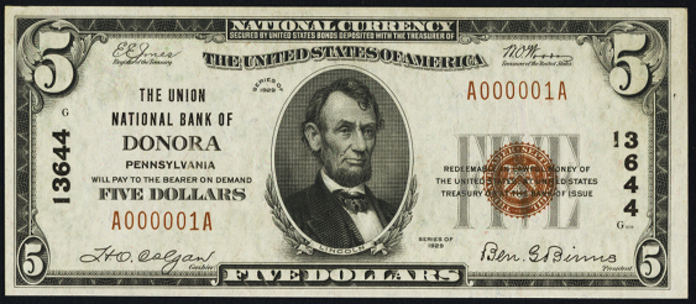Five Dollar Notes › Nationals › 1929 Five Dollar National Bank Notes › California Charters › 1929 $5 Berkeley California College National Bank
Get Value Now
| Item | Info |
|---|---|
| Series | 1929 |
| Charter | #11495 College National Bank of Berkeley, California |
| Year Chartered | 1919, 288 Banks Chartered |
| City Info | Berkeley is a city on the east shore of San Francisco Bay in northern Alameda County, California. It is named after the 18th-century Anglo-Irish bishop and philosopher George Berkeley. It borders the cities of Oakland and Emeryville to the south and the city of Albany and the unincorporated community of Kensington to the north. Its eastern border with Contra Costa County generally follows the ridge of the Berkeley Hills. The 2010 census recorded a population of 112,580. Source: Wikipedia |
| Similar Cities | If your note doesn't match try: 1. Berkeley, California - First National Bank 2. Berkeley, California - Berkeley National Bank 3. Berkeley, California - First National Bank 4. Berkeley, California - Commercial National Bank 5. Berkeley Springs, West Virginia - Citizens National Bank |
| Seal Varieties | Small Brown |
| See Also | If your note doesn't match try: 1. 1929 $5 Federal Reserve Bank Note 2. 1928 $5 Federal Reserve Note 3. 1928A $5 Federal Reserve Note 4. 1928B $5 Federal Reserve Note 5. 1928C $5 Federal Reserve Note 6. 1928D $5 Federal Reserve Note 7. 1934 $5 Federal Reserve Note |
| Other Info | 1. Value depends on notes known for charter, condition and market demand. |
| Neat Fact | Notes from common charters are less valuable compared to rarer charters. Value also depends on type, denomination and total notes known for city, state and region. Ultimate determination of value is collector demand. |
No Obligations Offers and Appraisals
Please submit a good photo or scan. It will be identified and evaluated. Understand there may be subtle differences between the image you see above and your note. Signatures, design, markings and note condition will determine the offer price. Notes in Uncirculated or better condition receive the best offers.
Appraisals can be estimated for wholesale and retail prices. Wholesale is what dealers typically pay. Retail is what a collector might pay. Retail is slightly higher in most cases.
Please visit this page for USA Paper Money Reference. Do not treat this page as a reference guide, it is for appraisal and acquisition purposes only.
